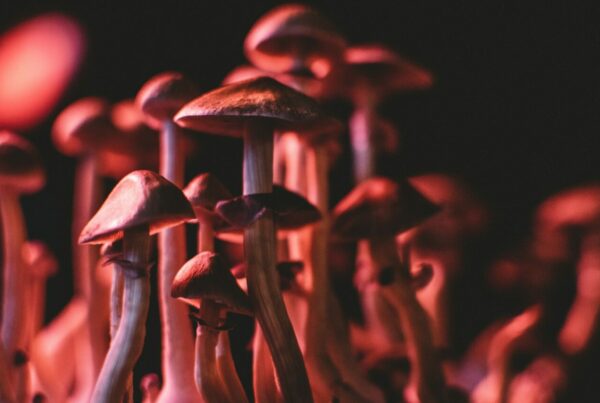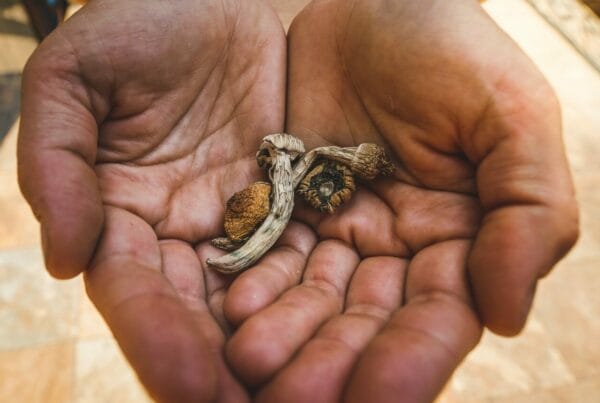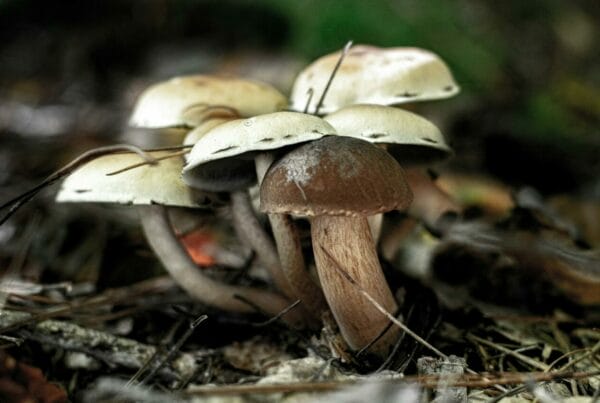Originally, the strength of Psilocybe mexicana was thought to be mythical. However, this view has dramatically evolved due to ongoing psilocybin research. The psychedelic research community consistently uncovers its therapeutic benefits, gradually leading to its recognition in the medical community. The expansion of this field is encouraging, with experts continuously working to determine safe dosage levels for medicinal use.
Key Takeaways
- Innovative techniques such as liquid chromatography combined with tandem mass spectrometry are used by researchers to measure the potency of mushrooms.
- Psilocybe Mexicana, among various other mushroom species, is currently being examined in clinical trials for potential therapeutic applications.
- Diversity in the genetic makeup of magic mushrooms plays a critical role in formulating accurate dosage guidelines.
Psychedelic Mushrooms: Emerging from the Shadows into Research Revelations
In the past, only a few conditions were known to be alleviated by Psilocybe Cubensis. However, psilocybin is currently making substantial progress in uncovering its concealed medicinal properties.
Researchers are exploring the potential of Psilocybe Mexicana and other powerful strains for extensive research and clinical trials. Whether the subjects are in vivo or in vitro, these strains have proven effective in showcasing the genuine effects and benefits of the fungus species.
Psychedelics Gaining Market Acceptance
Once concealed, now exposed—continuous progress and findings are increasingly attracting public attention, especially those seeking therapeutic solutions. Conventional treatments for mental health disorders often prove inadequate, leading individuals to search for more effective alternatives.
Welcome, magic mushrooms.
Patients dealing with mental health conditions are resorting to psilocybin, which has demonstrated potential in treating depression, alcohol addiction, anxiety, compulsions, tics, chronic pain, and more.
Currently, medical professionals are investigating innovative ways to precisely calibrate the optimal dosage for safe patient administration. Notably, a research team from the University of Texas has created a model to extract psilocybin and psilocin concentrations.
It’s feasible to determine the clinical potency of magic mushrooms.
Distinctive Traits of Mexicana
Golden Teachers, Blue Meanies, and B-Plus are among the magic mushrooms that have been extensively researched. However, to deepen our understanding of safe usage of these fungi, studies need to include a wider range of species.
Among other species, the Mexicana species has garnered attention in the research community. Not only is it one of the oldest species, but its relatively mild potency also makes it more likely to comply with medical pharmaceutical standards.
Even though the Mexicana strain’s potency may be less than that of other species, it can still produce effects similar to more mainstream strains. With the rise in popularity of microdosing among patients, this strain becomes an attractive option.
The concentrations of psilocybin and psilocin in this species are consistent with those in other strains. So, what makes it stand out among other similar strains? Its significant historical and anthropological background provides the answer.
Diving Into a Rich “Mexican” Heritage
In the past, psilocybe mexicana naturally thrived in moss. These psilocybin mushrooms were highly esteemed by indigenous people for their varied uses, often associated with mystical or otherworldly phenomena.
Let’s focus on Mexican mushrooms. More than 2000 years ago, these mushrooms were first used by the native people of North and Central America. The Aztecs, an ancient civilisation, coined a term for these mushrooms in their native language, “teonanácatl,” which translates to “food of the Gods.”
Were the Aztecs still around today, they would attest to the transformative, emotionally potent, and mentally balancing effects of the Mexicana—despite their lack of familiarity with these contemporary terms.
Despite different cultivation techniques, this mushroom has succeeded in preserving its natural psilocybin levels, a testament to its authenticity. This authenticity is a standard that both researchers and institutions involved in psychedelic research greatly appreciate.
Innovative Methods for Testing Psilocybin Content and Potency
A collaborative team of ten researchers from the University of Texas at Arlington and other research institutions has pioneered a novel method for assessing the potency of psychoactive compounds in mushrooms. This innovative methodology integrates liquid chromatography and tandem mass spectrometry.
Below are the two groundbreaking techniques:
- Liquid chromatography functions as a technique for the separation and analysis of chemical compounds. In the context of psychedelic mushrooms, it is utilized to isolate active chemical constituents. The procedure involves conveying a liquid sample through a column packed with a solid substance, referred to as the stationary phase. The diverse set of chemicals within the sample have distinct interactions with both the stationary and mobile phases, leading them to separate at different rates as they transit the column.
- Spectrometry is primarily concerned with the study of matter’s interaction with electromagnetic radiation over a variety of wavelengths. It enables the identification and quantification of substances based on the specific light wavelengths that are absorbed and scattered by the molecules. Such interactions permit the characterization of the electronic, vibrational, and rotational states of a chemical compound.
The above methodology was employed on five strains of magic mushrooms. Upon investigation, researchers found that the mean total psilocybin and psilocin content across these strains ranged from 0.879 to 1.36. These concentrations exceeded those found in many other strains, such as the Bull Run and Cambodian varieties. They verified the reliability of their research by comparing their results to those of other independent laboratories.
The alignment of results between the two laboratories further supports the precision of their testing process in accurately assessing the potency of the mushrooms.
If these findings are validated by experts, it could lead to the incorporation of new methodologies into existing psychedelic strength testing procedures, acting as an additional safeguard against inaccurate dosage determinations.
Extending Research to Additional Species
The expansion of research to include other species is advantageous. It can elevate our comprehension of the health benefits associated with different strains, as well as provide foundational information regarding the effects of less potent mushrooms.
Moreover, it can contribute to enhancing public awareness about the influence of different dosages on the psychedelic experience. By juxtaposing the Mexicans strain with more potent strains like Psilocybe Cubensis, researchers can ascertain how the varying concentrations of active compounds can impact therapeutic results.
For example, the Blue Meanies strain is known to produce more potent hallucinogenic effects, which could potentially be effective in treating conditions like depression. On the other hand, lower dose strains are better suited for microdosing or more subtle applications such as improving mood or increasing focus.
Genetic Diversity Enhances Safety of Treatments
It is less recognized that distinct cultivars or varieties possess unique genetic profiles and
Psychedelic mushrooms vary significantly in terms of potency, chemical composition, and impacts. It’s this diversity that allows medical practitioners to select the most suitable variety for specific medical applications and adjust doses to meet individual requirements, thereby reducing potential risks while maximizing benefits.
Take for instance, Psilocybe Semilanceata (Liberty Caps) or Psilocybe cyanescens. Each of these possesses a distinct alkaloid profile that may be effective in managing anxiety. On the other hand, certain synthetically grown mushrooms might be more appropriate for addressing substance addiction or compulsive behaviors. This diversity paves the way for the development of personalized treatment plans that are safer and more effective.
Thus, we can infer that the genetic diversity found in hallucinogenic mushrooms, combined with innovative methods for evaluating potency and identification, is vital for devising safer medical treatments.
Enhanced Safety in Medical Applications
Let’s contemplate what safer dosing could imply.
- Decreased risk of overdose: Accurate dosing alleviates consumers’ concerns about overdosing, implying that product descriptions should be more transparent to avoid misunderstanding.
- Better predictability: Accurate dosing allows users to better predict potential effects or experiences during their trips, reducing overpowering sensations and anxiety and contributing to patient satisfaction.
- Standardized measurement: Accurate dosing could lead to a standardized measurement system, enabling people to quickly refer to charts for possible effects.
Experience the Benefits of Precisely-dosed Shrooms through Advanced Potency Tests | Buy Magic Mushrooms Online from Deadhead Chemist Canada
With the continuing advancements in these two techniques, you won’t have to worry about unpredictable effects. Couple this advantage with smart online shopping on Deadhead Chemist Canada. We offer dried mushrooms that provide a serene, relaxing psychedelic experience without excessive psychoactivity. Buy psychedelics online in Canada from Deadhead Chemist Canada.
Frequently Asked Questions
Is Psilocybe Mexicana from Mexico similar to Big Mexicans?
Are Big Mexicans and Psilocybe Cubensis the same?
No, Big Mexicans and Psilocybe Cubensis are different mushroom strains, so it’s crucial not to confuse the two. Big Mexicans have a higher compound concentration, ranging from 0.5% to 1%, making them significantly more potent.
Psilocybe Cubensis and Mexican mushrooms aren’t identical. The key differentiator is often in their appearance, with the former frequently sporting a bell-shaped cap and the latter, a conical one.
What’s the highest concentration of psilocybin in Mexican mushrooms?
The psilocybin and psilocin concentration in Mexican mushrooms can peak at 0.25%. Although these levels are comparably low to those found in the Golden Teacher strain, they can still induce potent psychedelic experiences, that may have potential health benefits.
What’s the recommended safe dosage for medical use?
Typically, a dose ranging from 1 to 2 grams is recommended. But this can fluctuate depending on factors like the method of consumption, individual metabolism, and the specific potency of the strain. To mitigate the hallucinogenic effects, some people opt for sub-threshold doses ranging between 0.05 (50mg) to 0.025 grams (250mg).





